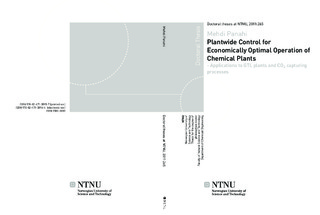| dc.contributor.author | Panahi, Mehdi | nb_NO |
| dc.date.accessioned | 2014-12-19T13:23:31Z | |
| dc.date.available | 2014-12-19T13:23:31Z | |
| dc.date.created | 2012-01-17 | nb_NO |
| dc.date.issued | 2011 | nb_NO |
| dc.identifier | 479319 | nb_NO |
| dc.identifier.isbn | 978-82-471-3095-7 | nb_NO |
| dc.identifier.uri | http://hdl.handle.net/11250/248272 | |
| dc.description.abstract | In this thesis, the systematic plantwide procedure of Skogestad (2004) is applied to two processes;
1- Post-combustion CO2 capturing processes,
2- Natural gas to liquid hydrocarbons (GTL) plants, in order to design economically efficient control structures, which keep the processes nearoptimum when disturbances occur. Because of the large magnitude of energy consumption in both these processes, optimal operation is of great importance.
The self-optimizing concept, which is the heart of the plantwide procedure is used to select the right controlled variables in different operational regions, which when they are kept constant, indirectly give the operation close to optimum. The optimal is to reconfigure the self-optimizing control loops when the process is entered into a new active constraint region, but we try to arrive at a simple/single control structure, which does not need switching, where a reasonable loss in operating economic objective function is accepted.
The CO2 capturing process studied here is an amine absorption/stripping system. The chosen objective function for this process is first to minimize the energy requirement while fixed CO2 recovery of 90% is met. This leads to one unconstrained degree of freedom. Maximum gain rule is applied and a temperature close to the top of the stripper is found as the best controlled variable. Further, we introduce penalty on CO2 amount released to the atmosphere, and this results in two unconstrained degrees of freedom. CO2 recovery and a temperature close to the top of the stripper are found as the best individual controlled variables in low feedrate. In higher flue gas flowrates, stripper heat input saturates and the self-optimizing method is repeated to select the right controlled variable for the remaining degree of freedom. We validate the propose control structures using dynamic simulations, where 5 different alternatives including decentralized control loops and multivariable controller are studied. We finally achieve a simple control structure, which handles a wide range of change in throughput and keeps the process close to optimum without the need for switching the control loops or updating the controlled variables setpoints by a costly real time optimizer.
The GTL process modeled in this thesis includes an auto-thermal reformer (ATR) for synthesis gas production and a slurry bubble column reactor (SBCR) for the Fischer-Tropsch (FT) reactions. The FT products distribution is determined using a well-known Anderson- Schultz- Flory (ASF) model, where carbon component in CO (consumption rate is found based on the proposed rate by Iglesia et al.) is distributed to a range of hydrocarbons. ASF is a function of chain growth probability and the chain growth is a function of H2/CO ratio. We study different scenarios for chain growth and we arrive at a suitable model for optimal operation studies. The optimal operation is considered in two modes of operation. In mode I, natural gas feedrate is assumed given and in mode II, natural gas feedrate is also a degree of freedom. After optimization, in both modes, there are three unconstrained degrees of freedom. The best individual self-optimizing controlled variables are found and since the worst-case loss value is rather notable, combination of measurements is done, which reduces the loss significantly. Mode II happens when oxygen flowrate capacity reaches the maximum and we show that operation in mode II in this case is in snowballing region where operation should be avoided. Operation at maximum oxygen flowrate capacity is where maximum practical profit can be achieved. | nb_NO |
| dc.language | eng | nb_NO |
| dc.publisher | Norges teknisk-naturvitenskapelige universitet, Fakultet for naturvitenskap og teknologi, Institutt for kjemisk prosessteknologi | nb_NO |
| dc.relation.ispartofseries | Doktoravhandlinger ved NTNU, 1503-8181; 2011:265 | nb_NO |
| dc.relation.haspart | Panahi, Mehdi; Karimi, Mehdi; Skogestad, Sigurd; Hillestad, Magne; Svendsen, Hallvard F.. Self-Optimizing and Control Structure Design for a CO<sub>2</sub> Capturing Plant. Proceedings of the 2nd Annual Gas Processing Symposium - Advances in Gas Processing: 331-338, 2010. | nb_NO |
| dc.relation.haspart | Panahi, Mehdi; Skogestad, Sigurd. Economically efficient operation of CO(2) capturing process part I. Chemical Engineering and Processing. (ISSN 0255-2701). 50(3): 247-253, 2011. <a href='http://dx.doi.org/10.1016/j.cep.2011.02.005'>10.1016/j.cep.2011.02.005</a>. | nb_NO |
| dc.relation.haspart | Panahi, Mehdi; Rafiee, Ahmad; Skogestad, Sigurd; Hillestad, Magne. A Natural Gas to Liquids Process Model for Optimal Operation. Industrial & Engineering Chemistry Research. (ISSN 0888-5885). 51: 425-433, 2012. | nb_NO |
| dc.relation.haspart | Panahi, Mehdi; Skogestad, Sigurd; Yelchuru, Ramprasad. Steady State Simulation for Optimal Design and Operation of a GTL Process. Proceedings of the 2nd Annual Gas Processing Symposium - Advances in Gas Processing: 275-284, 2010. | nb_NO |
| dc.relation.haspart | Gera, Vivek; Kaistha, Nitin; Panahi, Mehdi; Skogestad, Sigurd. Plantwide Control of a Cumene Manufacture Process. 21st European Symposium on Computer Aided Process Engineering: 522-526, 2011. | nb_NO |
| dc.title | Plantwide Control for Economically Optimal Operation of Chemical Plants: - Applications to GTL plants and CO2 capturing processes | nb_NO |
| dc.type | Doctoral thesis | nb_NO |
| dc.contributor.department | Norges teknisk-naturvitenskapelige universitet, Fakultet for naturvitenskap og teknologi, Institutt for kjemisk prosessteknologi | nb_NO |
| dc.description.degree | PhD i kjemisk prosessteknologi | nb_NO |
| dc.description.degree | PhD in Chemical Engineering | en_GB |

